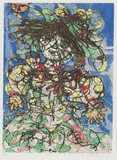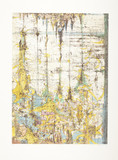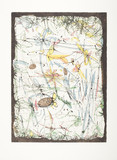Born in Obihiro, Hokkaido, graduated from Hokkaido University of Education. In 1959 he established his studio and submitted prints to the Hokkaido Hanga Kyōkai (Hokkaido print society). He became active also in the Shunyōkai 春陽会 Art Association, the Nihon hanga kyōkai 日本版画協会 the Japan print association, and Zendō bijutsu kyōkai 全道美術協会 the All Hokkaido Art Associaton. At the All Hokkaido Art Associaton exhibitions of 1960, 1961, and 1962 he won respectively an encouragement prize, an endorsement prize, and a nomination prize for full membership. Shibuya studied etching in Paris in 1971 and 1972 at Freidlander Atelier, drawing at Academy Grand Chaumiere and again etching at Stanley Hayter's Atelier 17. He returned to Europe in 1977, 1988 and 1991 to study wood engraving and other media. In 1975 with the artists Okabe Masao, Tamamura Takuya, Hanada Kazuharu, Yazaki Katsumi, and Watarai Junsuke (all important print makers) established Prints and Six People 版と6人, intending to limit the genre of their exhibitions to prints. The next year the group added Kunimatsu Asuka and Horiuchi Kikuo, then in 1979 Ishigaki Mitsuo and Ueno Norio joined, and in the late 1970s this group was at the center of the Hokkaido Art scene lauching yearly exhibitions. Then in 1990 through 1996 they organized yearly exhibitions called the "10 Person Space Exhibition". In 2003, the Obihiro Art Museum gave a solo exhibition to Shibuya Eiichi. That museum holds some of Shibuya's best works. In the spring of 2009, at the Black Forest Museum (privately extablished) in the middle of the woods of Kitahiroshima (in Ishikari, Hokkaido), a work by Shibuya went on permanent display. Shibuya had other solos exhibitions in Paris, Tokyo, Kyoto, Kitakyushu, Kofu, Shizuoka, Sendai, Sapporo, and Asahikawa. Other museums holding his works include the Hokkaido Prefectural Museum, the National Museum of International art, Osaka, the National Library, Paris and the Cincinnati Art Museum. Shibuya is known for his color etchings of Parisian scenery, having black outlines that don't relate to objects in the work but enliven the surface. He used light, harmonious colors.
Eiichi Shibuya
5 records
Include records without images
About this artist




